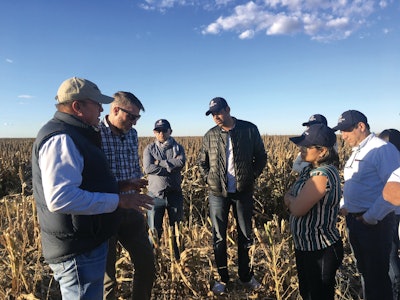
Whether it’s the climate conditions in Malaysia or the political nuances in Mexico, global markets are as multi-faceted as diamonds. Just like those precious jewels — with cut, clarity and carats — there are also overall qualities of global grains market development that the U.S. Grains Council (USGC) focuses on to ensure U.S. grains continue to flow to meet the needs of a growing world population.
The USGC works in more than 50 countries and the European Union to develop new markets for U.S. corn, sorghum, barley, distiller’s dried grains with solubles (DDGS )and ethanol, based on each country’s need for feed grains, not unlike determining different diamond cuts — from round to oval to marquis. The Council’s efforts are based on the pillars of information and research, business-to-business relationships, marketing and trade policy, with each aspect of the approach unique for the country and culture at hand.
Accurate research
For U.S. corn, the USGC issues two reports annually — the Corn Harvest Quality Report and the Export Cargo Quality Report — to help international buyers understand the initial quality of U.S. yellow commodity corn as it enters the merchandising channel and as it is assembled for export.
The 2018/2019 Corn Harvest Quality Report was released in January citing that a warm and moist growing season that resulted in good quality corn in near-record yields. The technical report offers descriptions of kernel size, projected national crop size, how the crop rated on the U.S. Department of Agriculture’s Federal Grain Inspection Service (FGIS) grading system, test weight per bushel and aflatoxin and vomitoxin levels — all important factors for decision makers responsible for purchasing in their countries.
To coincide with the release of this valuable information, the Council offers corn quality roll-outs and roadshows that bring together potential buyers around the world with U.S. farmers and researchers who can answer questions about the incoming annual U.S. corn crop.
Presentations, meetings and conferences aim to arm participants with clear expectations regarding the quality of corn for this marketing year. During these events, crop quality information is accompanied by facts on U.S. corn grading and handling, which helps provide a better understanding of how U.S. corn is moved and controlled through export channels.
This year, the events began in Southeast Asia with an unprecedented 370 buyers in Vietnam, Thailand and the Philippines. Similar events were also held around the world in countries and regions including Mexico, Colombia, Taiwan, Japan and Korea as well as the Middle East and North Africa.
The Corn Harvest Quality Report will be supplemented by a second report, the 2018/2019 Corn Export Cargo Quality Report, scheduled for release this spring, to measure corn quality at export terminals at the point of loading for international shipment.
Relationship building
Partnerships with industry leaders can lead to stronger, more dynamic industries, and strategic presence builds awareness of U.S. grains among international representatives. That’s why the USGC has a full-time presence in 13 key markets and representatives in an additional 15 locations.
Having eyes and ears on the ground in these countries allows Council staff to build relationships with buyers at local meetings and events, often supplemented by bringing them to see the U.S. corn crop for themselves.
Through trade teams and missions, the Council offers reciprocal visits: U.S. farmers travel to distant countries that buy their grain, and buyers from these countries come to the U.S. to see crops in the field, tour milling and transloading facilities and see firsthand how ethanol and DDGS are rendered.
Every other year, the Council and its industry partners sponsor an event called Export Exchange to bring overseas buyers together with U.S. sellers and trade officials to facilitate sales of U.S. grains. In 2018, 200 attendees from 35 countries gathered in Minneapolis for this meeting, and sales of DDGS and U.S. grain sales topped the $400 million mark.
Other Council marketing efforts have recently focused on ethanol sales. In the fall of 2017, the Council hosted the Ethanol Summit of the Americas that brought together more than 150 government and industry officials from more than 15 countries to discuss current and future opportunities for ethanol usages in the region.
The Council hosted a similar event in 2018 with a focus on Asia. Calling it the Ethanol Summit of the Asia Pacific, the meeting was similarly successful and included buyers from 17 countries.
To build on that momentum, the Council plans to offer ethanol events in key countries and regions as well as additional, similar forums in the U.S. in 2019.
Trade policy
The United States is the world’s largest agricultural exporter, and with domestic food markets maximized, U.S. farmers need exports for continued profitability and growth.
No market development effort is more valuable to the U.S. grains industry than free trade agreements (FTAs) with other countries, and the USGC’s staff is uniquely positioned to offer advice and counsel to those negotiating them.
The U.S. has FTAs in place with 20 countries – partners who purchased half of all exports of U.S. feed grains in all forms (GIAF) according to the U.S. Department of Agriculture (USDA) trade data and analysis by the Council.
From the recently signed U.S.-Mexico-Canada Agreement (USMCA), which builds on the long-time North American Free Trade Agreement (NAFTA), to the U.S.-Korean Free Trade Agreement (KORUS), which stabilized one of the U.S. ag industry’s strongest markets, Council staff members globally are engaged and involved in each negotiation on behalf of U.S. grain farmers.
Council staff members in Washington and overseas are working to help our government prepare for new trade talks with Japan, the European Union and the United Kingdom. This involves diligently gathering information from Council members and overseas stakeholders that we then translate into testimony and comments submitted to negotiators leading the charge for new agreements.
Balancing it all
Acheiving global market access and market development are critical for corn, sorghum, barley, DDGS and ethanol. The pillars of technical information, marketing, and trade policy the Council has built its strategy upon help address the multi-faceted and unique needs of each country in which it works with local customers, partners and governments.
The diversity of the Council is key to the work it does — from farmers to traders and agribusinesses, each role is important in the Council’s mission of developing markets, enabling trade and improving lives. Working with those diverse perspectives within the global trade market encourages effective and efficient trade for international customers, steady growth in world markets and political stability throughout the world. ■
Kurt Shultz is the senior director of global strategies for the U.S. Grains Council, a nonprofit organization that promotes the global use of U.S. barley, corn, sorghum and related products including ethanol and distiller’s dried grains with solubles (DDGS). www.grains.org.

















